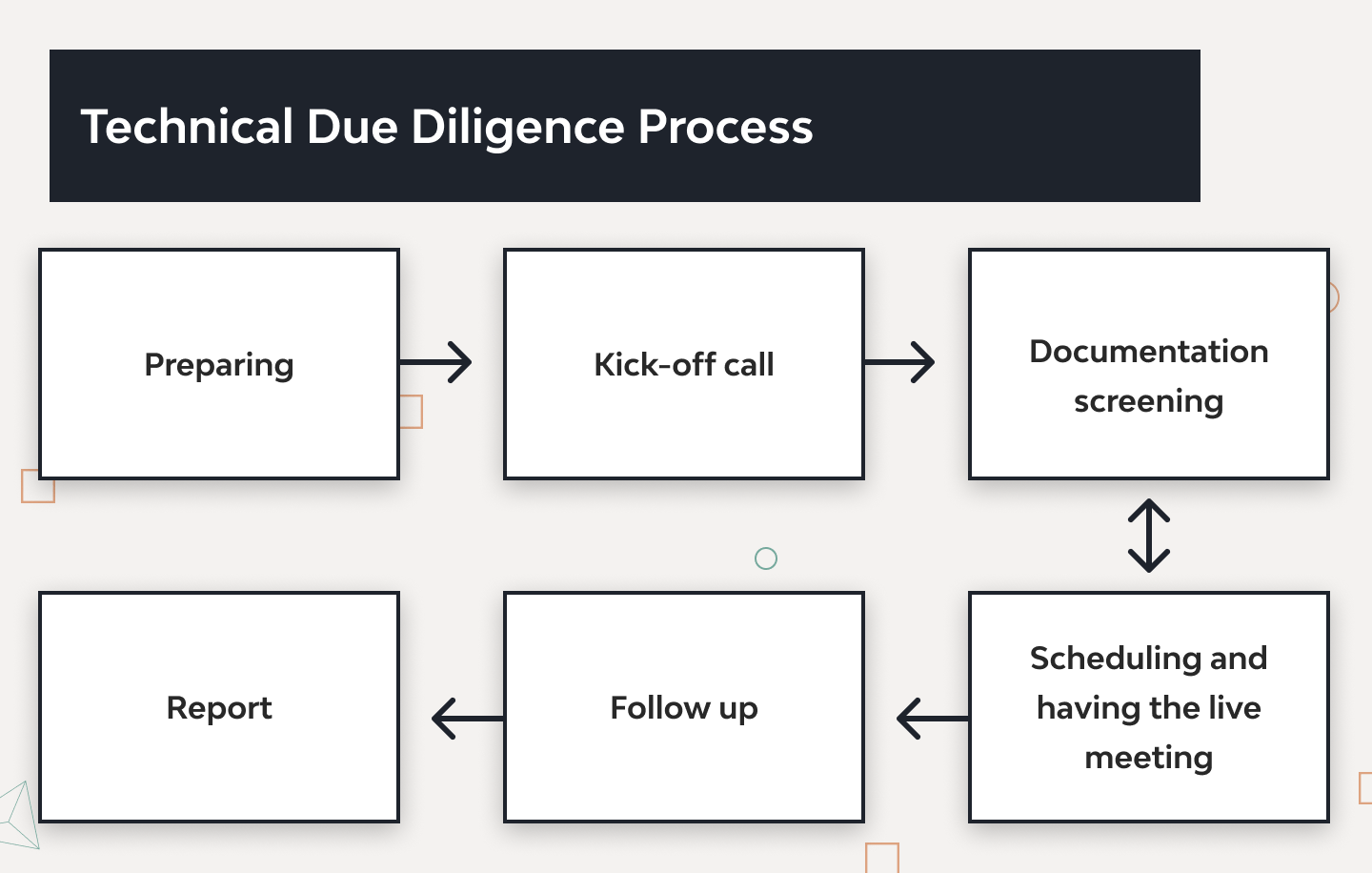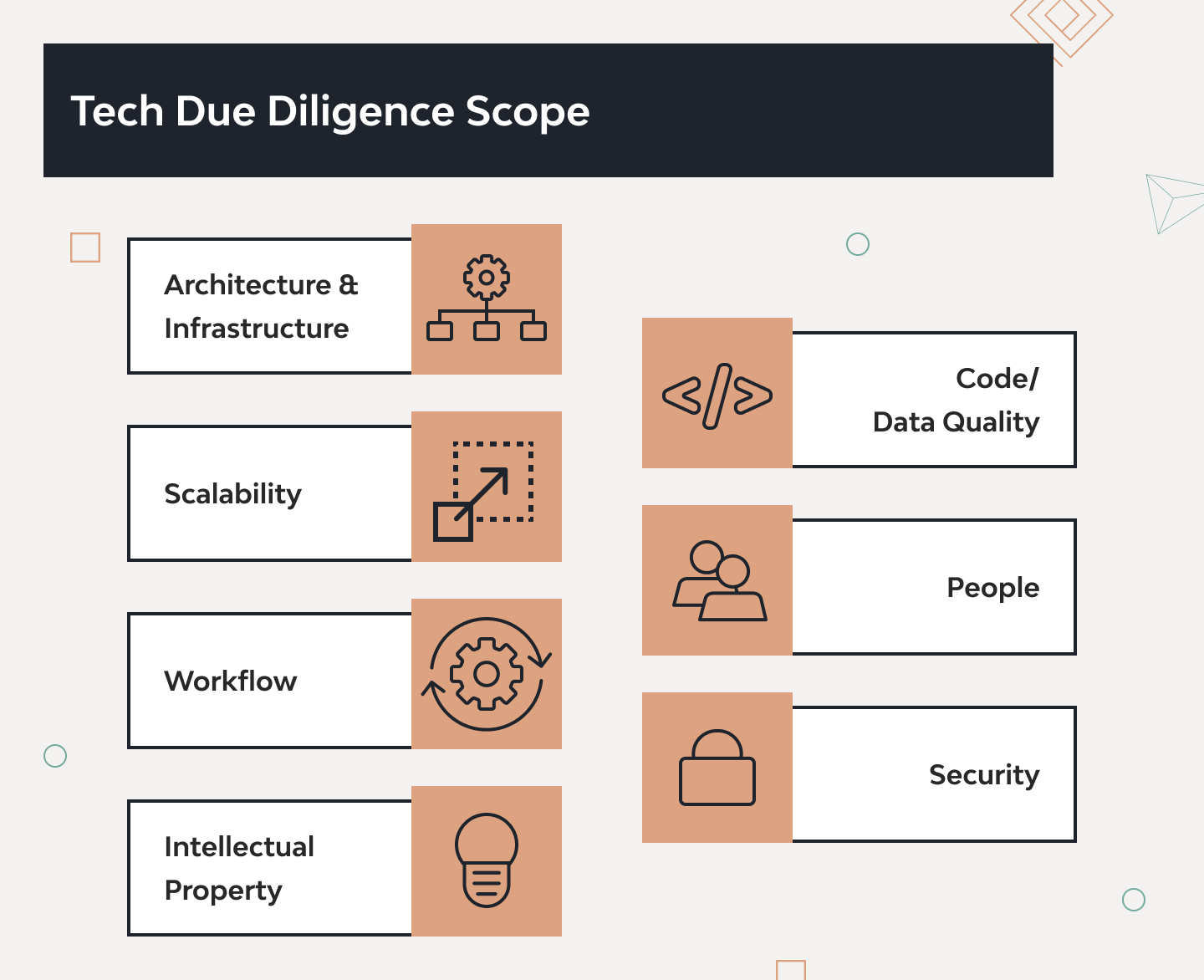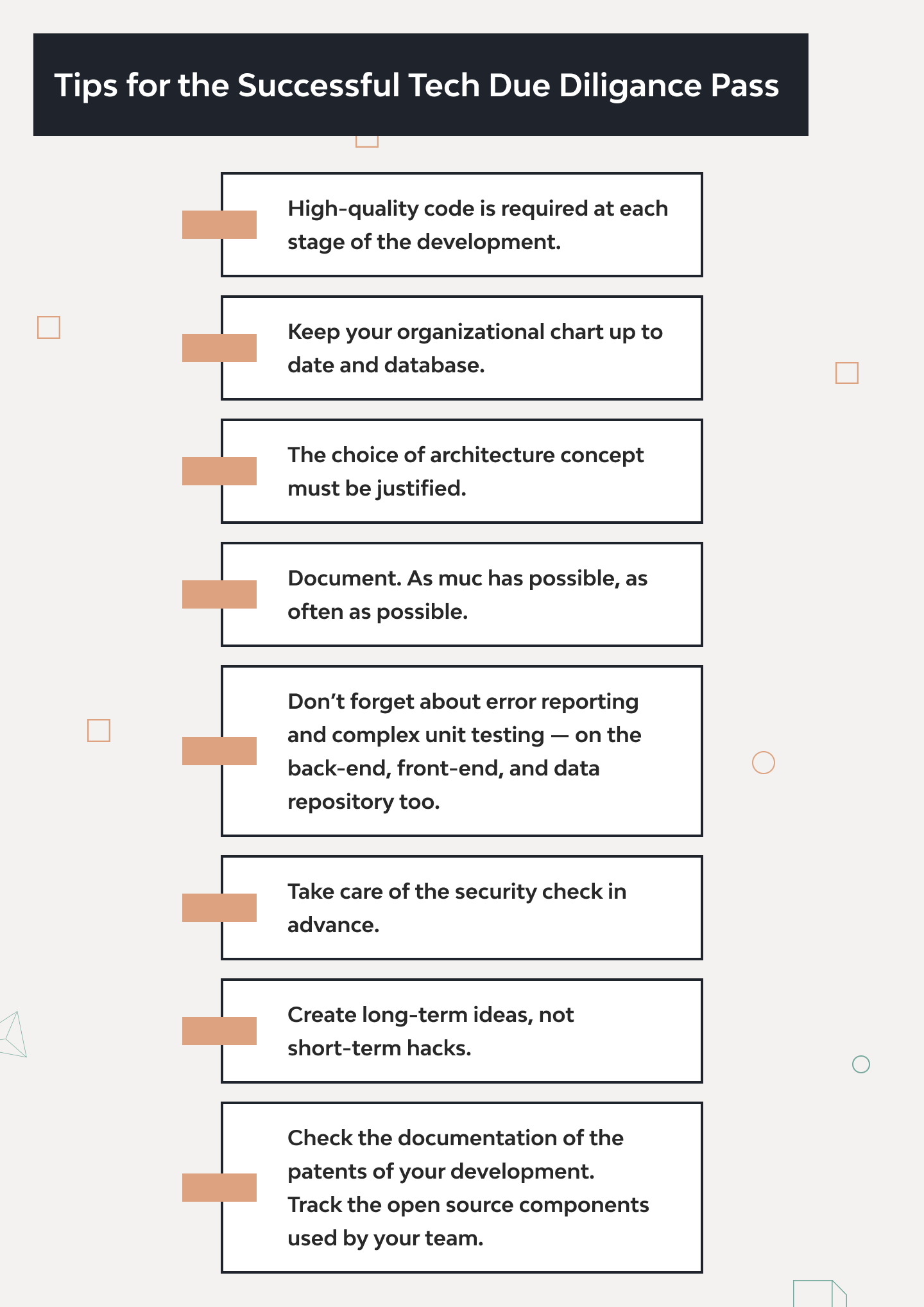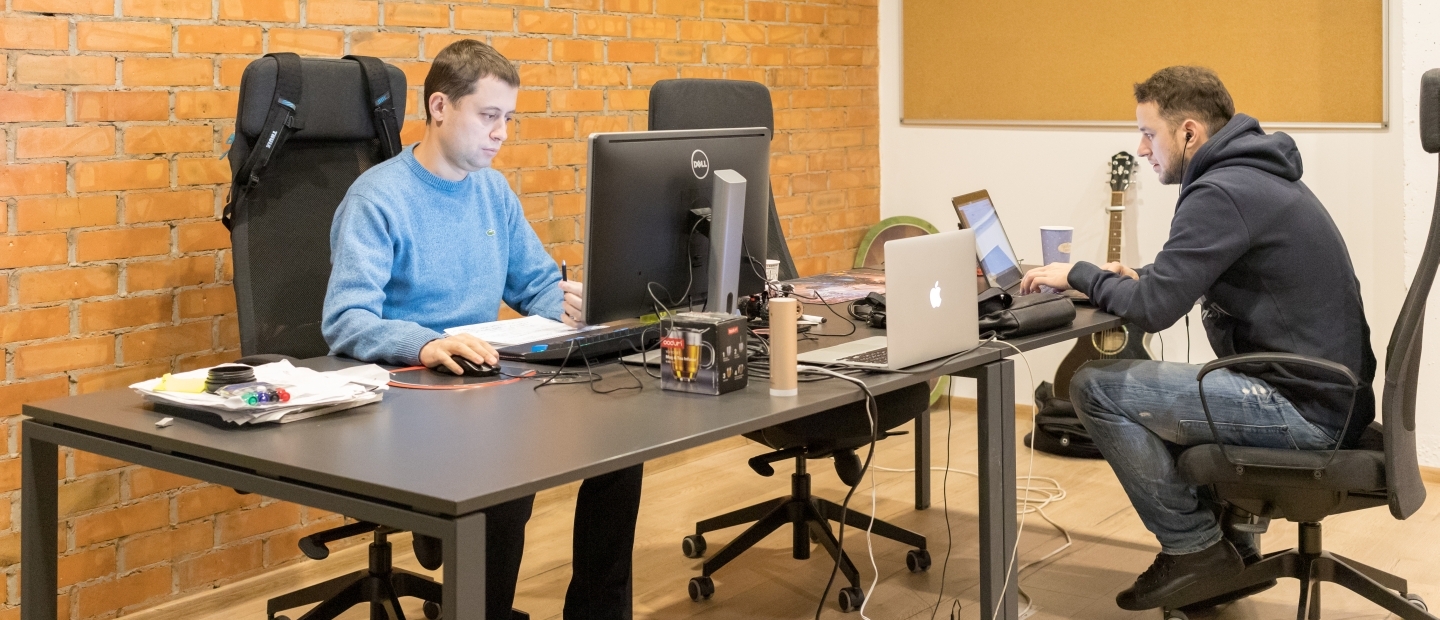Technical Due Diligence: Meaning, Process, plus Checklist
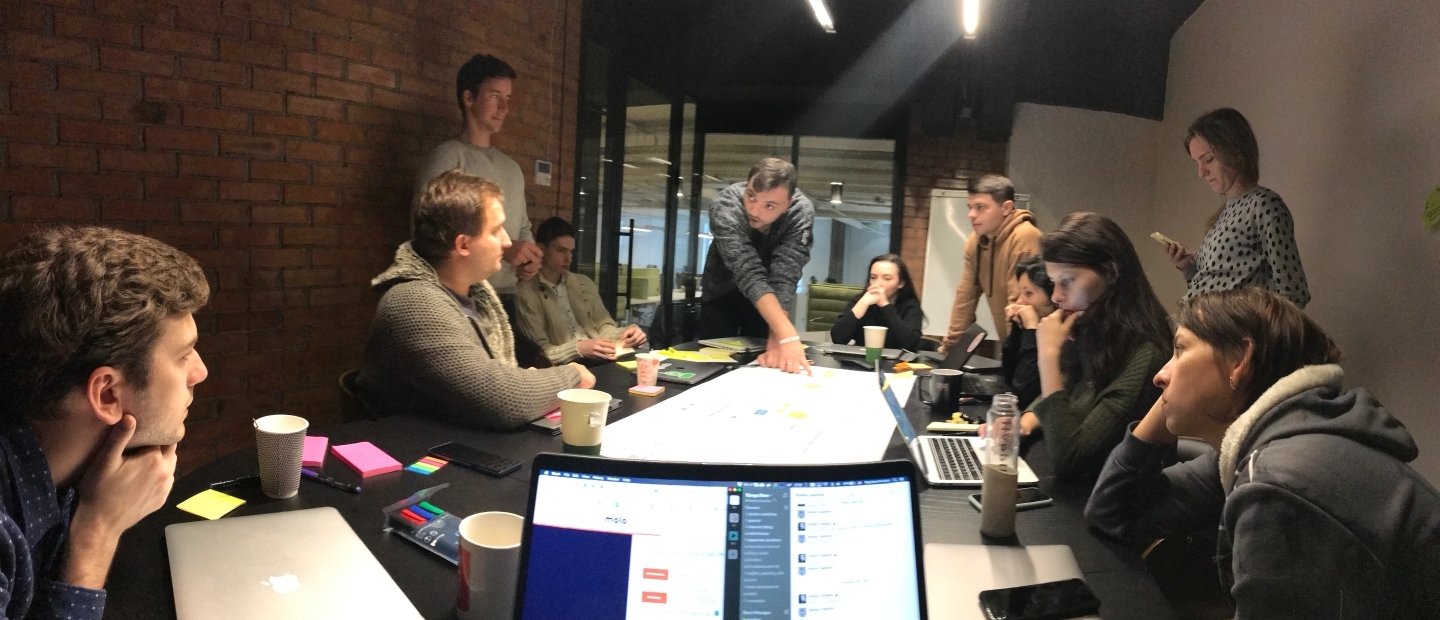
A technical due diligence audit is an unavoidable part of almost any IPO, M&A, or seed investment round. Yet, for most new companies, a startup due diligence check can be one of the most stressful parts of these processes.
Googling “technology due diligence” brings up a wealth of opinions and guides to passing an audit, but misinformation and scaremongering are common. Fortunately, with three ISO quality certification processes and numerous clients who have gone through the process, Django Stars can help. We know what product code and processes should look like to stand up to an IT due diligence audit and secure investment.
This article is a straightforward guide to the stages of due diligence and how to prepare a team for technical DD based on our experience. As a bonus, we’ve included an example of a technology due diligence checklist to help teams prepare for the questions technical due diligence officers are likely to ask.
Whether you’re a startup founder preparing for your first software due diligence audit or just need to brush up on best practices, continue reading this IT due diligence guide.
What Is Technical Due Diligence?
Transparency, risks, and prospects. Tech due diligence (or tech DD) is a comprehensive and independent audit of the technical condition of the product, code quality, the logic of the decision-making process, and the assessment of all possible risks before obtaining the necessary investments.
The technical due diligence process provides a development team with an in-depth analysis of the product’s strengths and weaknesses. At the same time, investors are making sure that they make the right choice investing in your project.
When is tech due diligence needed?
Before M&A (merger and acquisition), IPO, or getting a seed investment. For instance, venture fund Superangel conducts due diligence in early-stage startups before the pre-seed funding round.
Why carry out technical due diligence?
Reasons for conducting tech due diligence may vary. Investors want to ensure they invest in a reliable and safe product that will deliver on its promises (e.g., investment platform). To do this, they need to:
- Understand the competence of entrepreneurs
- Assess inherent risks
- Deeply study the technical side of the product and its prospects (which means any code shortcuts should be refactored before technical due diligence starts)
- Test the workload
- Forecast its payback
This makes sense: when investors want to join a startup or a software product, they are especially interested in recognizing technology risks and costs to reduce them. In turn, an IT due diligence audit enables startup owners to detect potential shortcomings of their products and rectify them in time.
In other words, well-performed tech due diligence is a pass card to investor interest.
Who conducts tech due diligence?
The initiator of tech due diligence is usually an investor. As a rule of thumb, it is an expert of the investment fund with a tech background or a third party agreed upon by the investor and the startup.
As a software vendor, Django Stars’ role is to help prepare clients for an audit by ensuring their product code is up to scratch, well-documented, and follows best practices. We can also help implement the requirements of a due diligence report — but more on that later.
Technical Due Diligence Checklist
Based on our experience, comprehensive technical due diligence covers the following risk areas:
- Customer service model (including security)
- Technological stack
- Innovation roadmap and capabilities (competitiveness)
The Django Stars information technology due diligence checklist covers the most common questions an auditor might ask. Download the guide here:

In the rest of this article, we’ll cover each aspect of the tech due diligence process in detail.
First of all, let’s talk about its key stages.
The Importance Of Technical Due Diligence
The key benefit to technology due diligence for an acquirer or investor is a transparent and cohesive look under the hood of the startup, ensuring no glaring issues with technology or security are present. TDD of a product shows its risks, cost, investment, and opportunities (RCIO) strategy; potential growth and scalability recommendations; existing IT spending analysis; and security posture and possible remediation approaches.
Naturally, every startup has to assess its prospects continuously. However, in rapidly growing projects, changes are so unpredictable that founders can sometimes shift focus from the concept with which they have started. At the same time, tech due diligence allows for verifying whether the existing product follows the initial idea.
On the investor side, a due diligence audit is key to clarifying financial risks. It also allows an investor to explore a product from the inside and judge its market potential.
There are also benefits of software due diligence for startups. Due diligence helps analyze all the product’s ups and downs, along with its strengths and weaknesses. While regularly assessing these is good practice in any software development process, an audit is a good opportunity for startups to take a step back and form plans for future development.
Technical Due Diligence Process
The IT due diligence process phases may vary depending on the stakeholders involved. For instance, in some cases, we were engaged as CTO on the client side (the company has a product, and we are its developers). In other cases, we participated as independent technical experts for code checks (identifying strong and weak points of a product) before passing due diligence.
Regardless of the kind of check, there are six main stages of technology due diligence template:
#1. Preparing
This is the initial step, where the software developer (either a startup or an outsourcing vendor) conducts a code review.
A code review is a full code check for errors, inaccuracies, and general programming style. It differs from the one that is performed when the pull requests are checked. This one is of a more general nature.
What does it include?
- Documentation review (examination of how fully it is described, its accuracy, and transparency)
- Code verification, integrations, components, and solutions
- Identifying strengths, such as unique solutions to programming problems and challenging implementations
- Coverage of weaknesses. Usually, these are the points that belong to the category ‘to be done later’
- Discovering how to work with these shortcomings in the future
- Prioritization
Naturally, it’s bad practice to be fixing code on the eve of tech due diligence. Instead, success at this stage mostly hangs on the three final points: identifying code weaknesses, investigating them, and prioritizing action to be taken.
#2. Kick-off call
The kick-off call is a discussion of the business side of the product and further due diligence stages.
The product vision, concept, market niche, and value proposition for users and prospects should be delivered to potential investors as straightforwardly as possible. This task falls on the CEO’s shoulders.
It’s not necessary to build a complicated plan for the first call. As representatives of venture fund Superangel point out, consideration of sales and marketing (not just code) will resonate with investors.
A potential funder will be interested in the uniqueness of the technology and market prospects, meaning they will appreciate an awareness of the product’s value for consumers and projected returns.
In our experience with technical due diligence, there was a second call with the product owner (the person on the client’s side who has the product requirements and delivers them to the developers).
#3. Documentation screening
Few people are passionate about documentation, but it can play a decisive role here.
Once everything is in order and a kick-off call with investors has gone well, the party responsible for conducting due diligence examines all the company’s existing documentation. This includes not only an overview of the architecture, integrations and tech solutions, backup and recovery, and servers but also the process frameworks for development.
A well-documented product will give due diligence analysts the information they need in less time and create a good impression of a product’s worth.
#4. Scheduling and having a live meeting
This stage marks a shift to internal processes. To review and explore them, a personal meeting with the developers is scheduled.
The tech due diligence officer (or team conducting the audit) will expect positive and productive communication with the project leader. It can be helpful to prepare slides of architecture and integration schemes.
The main goal of the tech diligence meeting is to convey the benefits and business value of the product and explain the logic and awareness behind past decisions.
#5. Follow-up
When the person conducting tech due diligence has gathered the needed answers and is ready to share the intermediate results of their assessment, they will usually be covered in a follow-up report. In Django Stars’ experience, this report can be given orally.
#6. Report
The final outcome of tech due diligence is a detailed report, as objective as possible, compiled by the reviewer based on document screening and meetings with founders, product owners, and tech leaders. Here, all the risks, pros and cons, and prospects are brought together and evaluated. Finally, the technical due diligence report is sent to the investors and the startup team.
These are the general stages of a due diligence process. The next step is to understand how IT due diligence works.
Key Elements of Technical Due Diligence
The focus of tech due diligence changes in different investment stages.
- At the Seed stage, technology due diligence focuses more on a startup’s prospects as the product is being developed.
- At stages А/B, this focus shifts to the development timeline, a startup’s business model, and projected profits.
- At stages C, D, and beyond, a startup is eager to expand, achieve maturity, and cooperate with like-minded startups, and tech due diligence also concentrates on these points.
Important! Writing high-quality code and documentation and establishing efficient processes are basic good practices for any development team and shouldn’t be introduced just for due diligence or when a startup needs investment.
During the technical due diligence process, the validity of decisions plays an important role. The critical goal for founders is to show how deeply they know their product, why certain decisions were made, and how they can justify the validity of these decisions in the future.
So, different investors carrying out tech due diligence inspect different sides of the product. For example, Superangel pays special attention to team, market, traction, and MVP (find out what MVP, MMP, MLP, and others are). Below is a detailed tip and the key elements a startup should work through based on our experience of conducting tech due diligence at Django Stars.
#1. Architecture & Infrastructure
At this stage of IT due diligence, the task is to describe the technology as much as possible and provide the prepared in-detail developer documentation. This might include product architectural descriptions, design documents, or API documentation. Moreover, investors will look for evidence of a product’s uniqueness based on research into competitor technologies.
At this stage, it’s key to invest resources wisely.
Startups at the beginning of product development have limited time and money. In this case, there is no point in spending a year on architecture development. Instead, developing a quickly-made prototype to test the idea will be more efficient. Moreover, such decisions should not be a point of embarrassment. An experienced vendor understands this and can suggest the right solution.
Important! The choice of architecture must be justified. Monolithic and microservice architectures are two very different approaches, and there is no right answer. The right choice depends on the project stage and its future goals. The tech due diligence checks it all together.
Should you make microservice architecture a goal?
In our practice, a client who had opted for a monolithic architecture actually impressed the tech diligence reviewer. It appears that many startups choose a microservice structure because of its high popularity among majors. But it’s complex. It requires decent team communication and is hard to test and monitor.
In the end, startups drown in microservices, as at the early stage, companies have limited resources and no time to stipulate the limits of microservices and properly integrate the architecture. With a monolithic architecture, additional services can be implemented through integrations. There are pros and cons everywhere.
The high costs associated with immature infrastructure are not what investors want. Therefore, a company’s choice of infrastructure should be rationalized by operational costs, opportunities, and risks throughout the entire product lifecycle.
Examples of questions to prepare for:
- What’s the type of architecture – monolith, microservices, serverless?
- Apps — native or not?
- How is the infrastructure built? — Who is the cloud provider? E.g., AWS, Google Cloud
- What are the code infrastructure features? E.g., Terraform, Docker, Kubernetes
#2. Code/Data Quality
During tech due diligence checks, investors pay particular attention to the code quality and the logic of the decisions made to avoid additional and unforeseen development costs in case the code is poorly written.
Important! Writing high-quality code should be done by an experienced team to avoid problems such as crutches, large technical debt, or unnecessary costs in the future. Startups also need to factor in error reporting and complex unit testing on the back-end, front-end, and data repository.
Examples of technology due diligence questions to prepare for:
- Is the stack hirable? Is it niche technology, or is there plenty of talent? What’s the onboarding speed?
- Are clean code/SOLID principles followed?
- Are common patterns and known technologies used?
- Modularization. Are abstractions in the right places, e.g., around external integrations?
- Are APIs well-structured, e.g., RESTful API?
#3. Scalability
All companies want to grow and expand, but not all consider how it will happen. Sooner or later, however, this need will arise, and an astute auditor will look for evidence that a company will be able to scale technically and expand the team.
Again, microservices (as opposed to a monolithic architecture) are not necessarily the right option here. A monolithic architecture can also be scalable with the right technical planning and strategy.
Important! Investors will look for long-term ideas, not short-term solutions. Ideally, a product will reach maturity and scale.
Examples of questions to prepare for:
- Is the system ready for unexpected growth?
- Have all safety aspects been considered?
#4. People
Each person in the team is endowed with a specific role, and the success of a product depends on how well and effectively they perform it.
Yet team engagement and collaboration are also crucial.
The task in this area is to convey the goal of the product to the entire team as clearly and fully as possible so that all members understand the rationale behind decisions.
Important! Always try to keep an up-to-date organizational chart. Keep a database with the resumes of all employees and contractors in an organized manner, as well as their contracts and associated costs.
Examples of questions to prepare for:
- Do you take competent people to the team and rely on them?
- Can team members manage themselves? Do they seek feedback?
- Are cross-functional teams productive? Do they have all the competencies to execute their plan, e.g., analytics, product owner, engineers, and design?
- What about ways of thinking? Can a software engineer in the team correctly take feedback from the end user, test, and measure the result?
#5. Workflow
An expert conducting due diligence will pay attention to operational processes, including iterations, quality assurance, security testing processes, deployment, codependencies, and other operations.
As a result, startups should be ready to describe clear workflows with roles and responsibilities for each developer.
Important! Document everything as much as possible and as often as possible.
Examples of questions to prepare for:
- Do you have a meeting schedule? E.g., daily, weekly, monthly, quarterly sessions or reports.
- Does the team work proactively or reactively?
#6. Security
Maximum possible security is a must-have for the product. This is how startups show they care about the user and respect their needs. It’s also at the top of the software development due diligence checklist.
Important! Security checks are essential in any development process and should be handled well in advance of tech due diligence.
One way to carry out security checks is to hire a company to test the product in terms of its resistance to security issues such as hacks, malware attacks, and fake accounts. This provides a more comprehensive check against official software quality standards.
The security check explains the tech strengths and weaknesses in development.
Examples of questions to prepare for:
- What precautions are taken to secure the product and system?
- Do you perform user testing? How regularly? (e.g., 3-5 users twice a week).
#7. Intellectual Property
Investors want confirmation that a product and concept are unique. In addition to an attribution report, startups will usually be required to provide patents confirming and protecting their intellectual property, as well as proof of non-infringement.
Important! Keep your finger on the pulse. Check the documentation of all development patents. During due diligence, be prepared to show that the product meets all the requirements. Track all open-source project components, including licenses and sources.
Examples of questions to prepare for:
- Do you update the company’s patents regularly?
- Do you track all open-source components used by the team?
- Are third-party components also documented?
All of these areas are complex, but they can be successfully addressed with the right approach. The question is how to set priorities and allocate resources correctly to ensure that technical due diligence is a mere formality.
Best Practices for Tech Due Diligence
Startup due diligence checks are unavoidable since any startup will consider M&A, IPO, or VC investment at some point. They can’t be shrugged off, but neither are they the goal — they are simply the means to ensure that product development is on the right track.
Good preparation for due diligence essentially means building the product correctly from the ground up:
- Follow code delivery best practices and avoid shortcuts. These provide short-term benefits but result in long-term technical debt, undermining future growth.
- Document everything in as much detail as possible. This will help immensely in case of code refactoring or going from monolithic to microservices later.
- Check the documentation of all third-party services.
- Consistently perform cybersecurity checks.
- Perform automated unit testing during every sprint, etc.
When the software development process is organized correctly, passing a TDD at any startup lifecycle stage becomes just another project, not a nightmare.
This is the key difference between working with information technology partners like Django Stars and freelancers or even in-house developers. Most developers have a mindset of “I have to meet the deadline, and when/if the TDD comes, I might not even be here,” so they can cut the edges to provide the deliverables on time.
As a reputable software development and consultancy company, Django Stars prepares clients for inevitable TDDs from the start. We make a detailed plan and build the product correctly from the get-go, so when you’re ready for an IPO or M&A, your product will pass technical due diligence without issues.
How Django Stars Can Help
Django Stars doesn’t perform TDD, but we have been involved in them as CTO for some of our clients under NDA. We have also acted as a third-party expert consultant for startups with products developed by other vendors. Finally, if you already have a report compiled by an expert, we can implement it to get your product back on track.
Do you still have doubts about upcoming tech due diligence? Invite Django Stars as a third-party expert to verify code and other aspects. We’ll help with reviewing, identifying strengths and weaknesses, and analyzing operational processes to ensure your product successfully passes an audit.
One More Thing
Don’t panic. At first, it can seem that technical due diligence is just an annoying series of hoops that you have to jump through and a distraction from what really matters. In fact, identifying the risks helps your business to work out the weaknesses and all parts of your tech landscape and further improve the development of your product.
- What are the benefits of tech due diligence?
The technical due diligence process provides the development team with an in-depth analysis of the strengths and weaknesses of the product while investors are making sure that they make the right choice investing in your product.
Tech due diligence is carried out with the following major objectives:
- to understand the competence of entrepreneurs
- to assess all the kept risks
- to deeply study the technical side of the product and its prospects (your hacks come up here, remember them?)
- to test workload (consumers will prefer a bug-free product)
- to forecast its payback
The result of tech due diligence is a detailed report where all the risks, pros and cons, and prospects are brought together and evaluated. It is sent to the investors and the startup team.
- How long does technical due diligence take?
- The duration of technical due diligence can vary depending on the complexity of the project or company being evaluated, as well as the specific objectives of the due diligence process and the aspects of the product that investors wish to inspect. Generally, it can take a few weeks to several months to complete a thorough technical due diligence review. Factors such as the availability of information or key personnel can also impact the time to complete the due diligence process.
- Which framework Django Stars is used for tech due diligence?
Regardless of the kind of check, there are six main stages of tech due diligence:
- Preparing (conducting a code review.)
- Kick-off call
- Documentation screening
- Scheduling and having the live meeting
- Follow up
- Report
- Does Django Stars work according to technical due diligence templates?
- The phases of the technical due diligence process may vary depending on the stakeholders involved in it. For instance, in our experience, in some cases, we were engaged as CTO on the client side (the company has a product, and we are its developers). In other cases, we participated as independent technical experts for code checks (identifying strong and weak points of a product) before passing due diligence. The choice of templates also depends on the specific objectives of the due diligence process.
- Can you provide an IT due diligence checklist in PDF or Word format?
- Yes, on this page, you can freely download the Technical Due Diligence Checklist prepared by our specialists -- just fill out the appropriate form above. The checklist contains questions that may interest the due diligence officer, including technical questions, questions about the code, and product and culture questions.


